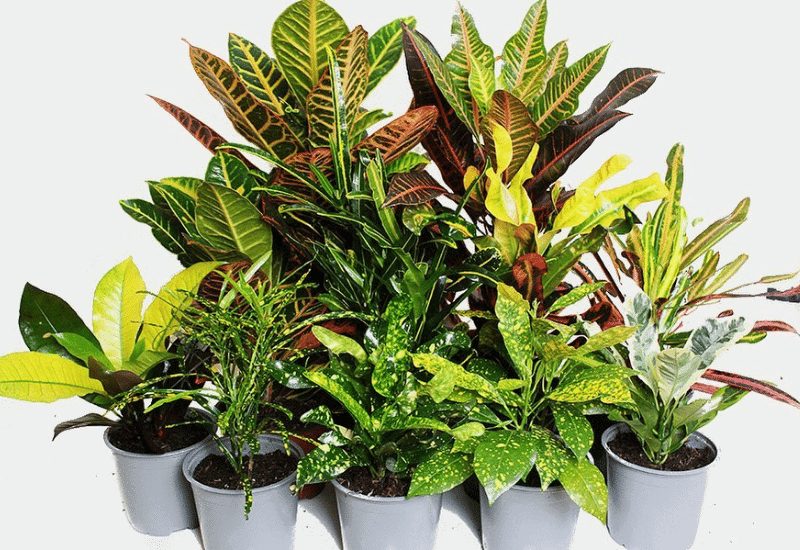
When it comes to vivid, colorful, variegated foliage houseplants, the Croton (Codiaeum variegatum) with its striking foliage, has no equal in bringing vibrant color and brightness to your indoor spaces. It’s easy to fallen for their charms!
A member of the Euphorbiaceae family and belongs to the genus Codiaeum, the Croton plant, aka Codiaeum variegatum includes more than 100 varieties of evergreen tropical shrubs and small trees.
And these cultivars and hybrids of croton have many differences in foliage color and shape, plant size and even personality.
Very showy, the foliage of flamboyant Croton, always leathery and glossy, comes in various forms. Depending on the variety the alternate leaves of Crotons can be long and narrow, lanceolate, cut, wide or rounded.
The same goes for the color, croton’s leaves offers an incredible variegations in a whole range of tints from yellow to green, passing through red, purple and black all spotted, ribbed or bordered.
To help you find your way in this brightly colored maze, we picked the best ever types of croton plant to grow as a houseplant or outdoors in pots…
But if you think that all that there is to crotons is that they make good houseplants, think again…
Let me explain before we meet these colorful wonders…
About Croton: More Than a Simple Houseplants
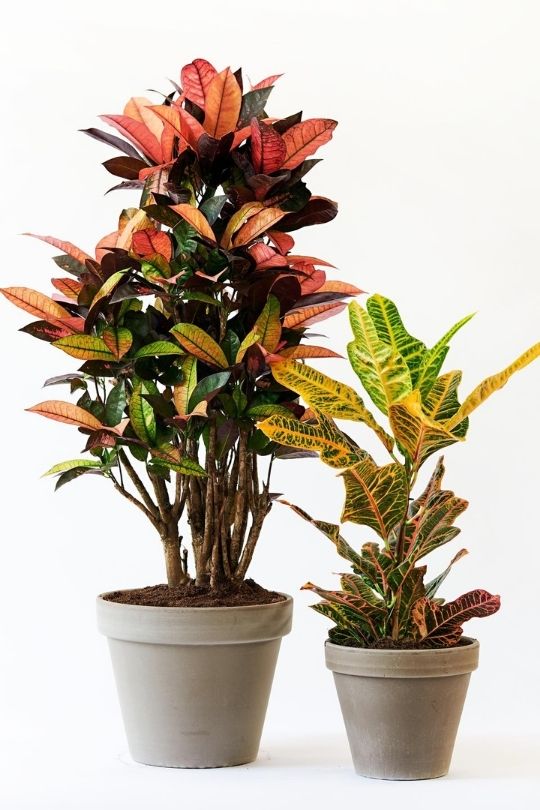
Croton is a genus of plants from Southeast Asia, but it contains much more than the many small varieties we usually see. In fact, there are perennials, shrubs and even trees that go by this name!
Note: The garden crotons (Codiaeum variegatum) are often confused with with genus Croton, which contain more than 700 species of perennials, shrubs, and small trees.
First described in the Seventeenth Century by Dutch botanist George Eberhard Rumpus, the name “croton” comes from the Greek rotos, which means “thick”, and it refers to the fleshy leaves that distinguish it.
What it does not say is that the foliage can also be extremely colorful, variegated and with different shapes, and this is why it has become a very popular and much loved houseplant.
And there is even more… In their natural habitat, crotons also produce flowers… You will hardly see these indoors, and we love them mainly for their lush foliage, but they do. These come in clusters and they are small, star shaped and in shades of white to lime yellow, usually.
And again, if you think that crotons are only houseplants, think again! They can grow outdoors in the right climate zone, which you guessed, are warm and mild, but if you do, you may well see their blooms as well.
The most famous croton in the world is not actually a croton, according to some botanists: its name is Codiaeum variegatum gives you a hint… But it can also be called Croton variegatum, and it is the one we all love and grow indoors and outdoors..
Finally, there is a famous variety, Croton tiglium, which provides one of the 50 fundamental herbs in Chinese medicine, and for this reason, it is the most useful of all, especially against constipation.
Used to the warm and humid climate of their native places, they have found a good environment in indoor spaces, and many varieties have been bred to meet the demands of its millions of admirers all over the world.
Croton Care Factsheet
Because there is a lot to say about croton, and because an easy to use factsheet may come in handy, here it is for you.
How to Care for Your Croton Plant
Now we need a few more words on how to make sure that your croton gets the care it needs and deserves…
Croton Light Requirements
Croton likes bright indirect light indoors, ideally 7 to 9 feet (roughly 2.0 to 3.0 meters) from a south facing window. It can tolerate medium indirect light, especially in warm places.
Outdoors, crotons prefer dappled and partial shade. If the Sun is too strong, it can damage the leaves, if it is too little, the plant will suffer and the leaf color will fade.
Croton Potting Mix and Soil
Croton likes fertile soil, like where it comes from, exotic forested areas with lots of organic matter.
Use a potting mix made of 3 parts sphagnum or peat moss based generic potting soil, 2 parts pine bark or coco coir and 1 part perlite or horticultural sand. Make sure it is good quality, and repot once you see roots growing at soil level, usually every two years.
If you want to grow it outdoors, make sure the soil is fertile and organically rich, well drained and loam based.
For croton, the soil pH should be mildly acidic (6.1 to 6.5) but it can manage quite low pH as well, to 4.5.
Croton Watering Needs
You need to keep the soil humid but never wet all the time. Check the top inch (2.5 cm) of soil; if it is dry, give it some water. Indoors, this means every 3 to 7 days in spring and summer, less in fall and winter, usually once a week.
Outdoors, you can be more flexible, but make sure that the soil never dries up completely. It is not at all drought tolerant.
Croton Humidity
The ideal humidity levels for croton are between 40 and 60%. Low humidity can cause leaf drop. So, if your room is dry, put a saucer under the pot and fill it with an inch of water. You can use expanded clay pebbles to extend its release.
Croton Temperature
The perfect temperature for croton is between 60 and 80oF, which is 16 to 27oC. If it drops under 55oF (13oC), it will start to suffer, if it goes above 80oF (27oC), it will not thrive.
However the extreme temperatures it can tolerate for a short time are between 40 and 100oF, or 5 to 30oC; outside this bracket, it risks dying.
Feeding Croton
Outdoors, simply use well balanced and mature organic compost, a few times a year, depending on how fertile is your soil.
Indoors, you will need a slow release organic fertilizer with NPK 3-1-2 or 8-2-10. While croton is a hungry plant, don’t overfeed it: once a month from spring to summer, then again once in fall, while in winter you can stop fertilizing it, as long as you start again early in spring.
Propagating Croton
It is basically impossible to propagate croton plants by seed, and your best choice is by stem cuttings.
18 Spectacular Croton Varieties To Fill Your Indoor Jungle
There are now more than 100 varieties of Codiaeum variegatum, or Croton variegatum, but the ones you are going to meet are the very best!
Here are 18 of our favorites croton plant varieties that run the gamut of foliage color, shape, and pattern.
1. Variegated Croton (Codiaeum variegatum; Croton variegatum)
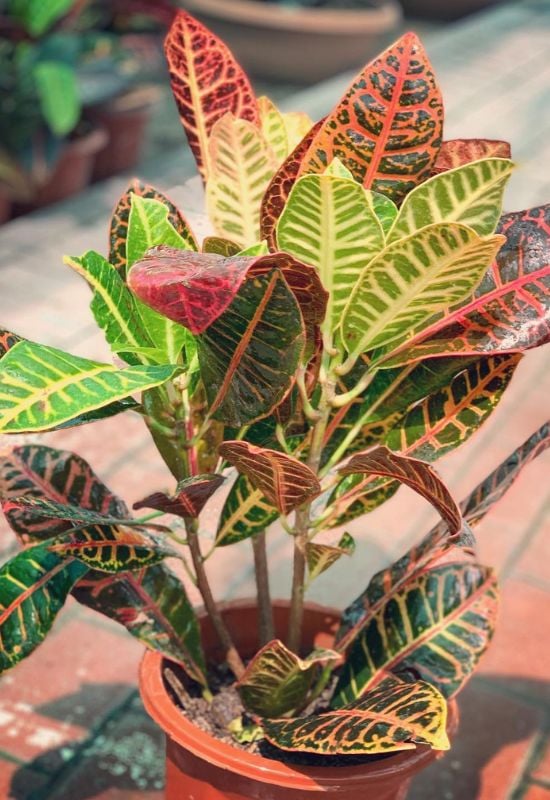
It’s only fair to start with the “mother species” from which all varieties and cultivars we grow indoors derive: variegated croton.
This small shrub has large leaves, up to 12 inches long (30 cm), and famously fleshy, glossy and colorful.
Their elliptical shape with a central rib in clear relief is heightened by the display of colors that will blow your mind away! Different shades of green, yellow, orange, red and even purple will draw patterns that follow the veins of the foliage, in a show that has earned it the nickname of “fire croton”.
Easy to find, variegated croton is arguably the most common variety ever, and it is likely one of the most popular houseplants ever.
2. ‘Mammy’ Croton (Codiaeum variegatum ‘Mammy’)
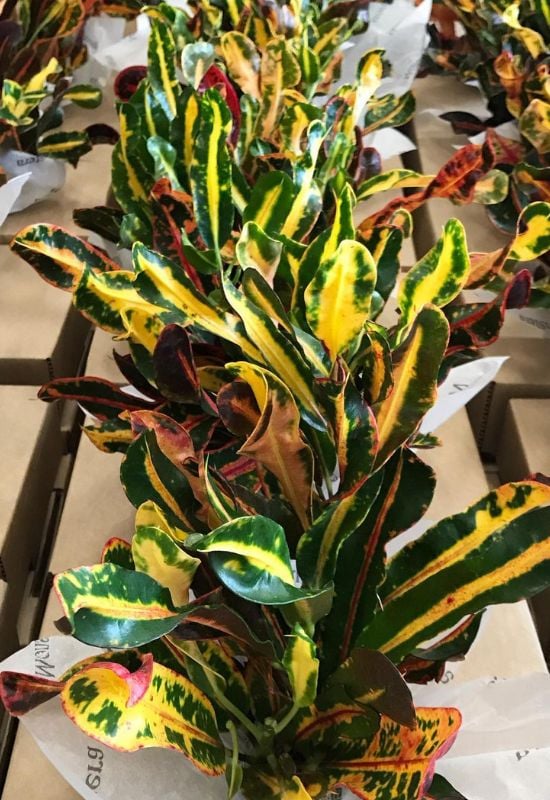
‘Mammy’ is the smallest variety of croton; it only reaches maximum 2.5 feet in height (75 cm) and it also has small, rose rounded and curly leaves.
But they come very dense on the little branches, and they don’t really lack in personality… In fact, they display all the palette of the natural species, with an explosion of colors: from bright to dark green, with yellow, red, orange, purple and even very dark violet purple areas. It all depends on the light, though, so, get ready for some pleasant surprises!
‘Mammy’ croton is compact but also very original, and it is ideal for small places, like coffee tables or working desks.
3. ‘Eleanor Roosevelt’ Croton (Codiaeum variegatum ‘Eleanor Roosevelt’)
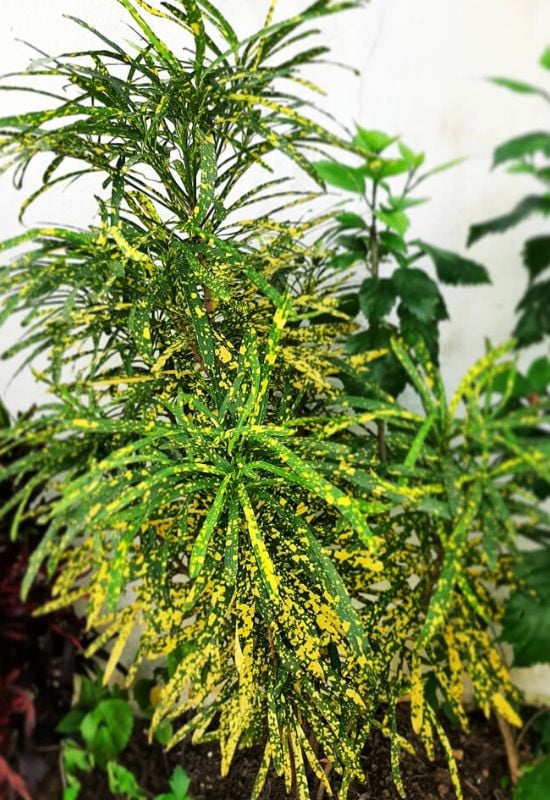
Dedicated to the famous First Lady, croton ‘Eleanor Roosevelt’ is quite distinctive. It has long, pointed and usually arching leaves, and these are fleshy but not as much as in other varieties.
Glossy and showy, they give you a lovely color contrast between the dark, deep green background they display when mature and the intense yellow patches that appear on them like on the skin of a leopard. While it does not have the chromatic range of other cultivars, it can still impress.
One of the most common garden varieties, ‘Eleanor Roosevelt’ croton is perfect for humid and shady spots under trees, in a woody area in partial shade, and it is popular in public parks in warm countries.
4. ‘Red Ice ton’ Croton (Codiaeum variegatum ‘Red Ice ton’)
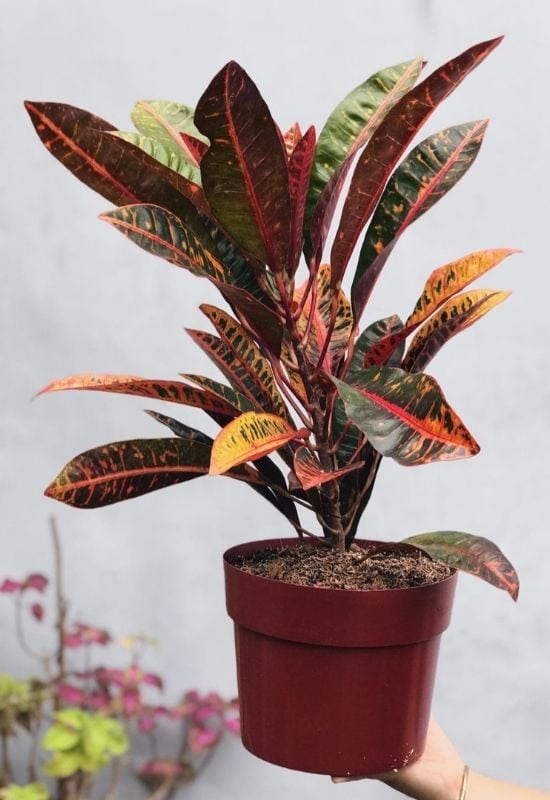
‘Red Iceton’ croton is perfectly described by its name: you will be amazed at the flaming red color of its leaves with very dark, almost black patches that variegate it.
Each elliptical leaf can reach 12 inches long (30 cm), and it is broad and with a gentle point at the tip.
Very leathery and glossy, they almost look like they belong to a plastic, or even rubber plant.
But they are all real and natural! The under pages tend to be darker, and sometimes, the red can turn yellow as well.
‘Red Ice ton’ croton is one of the best varieties for a bold statement; its large colorful and eye catching patches can draw eyes from a far distance!
5. ‘Andrew’ Croton (Codiaeum variegatum ‘Andrew’)
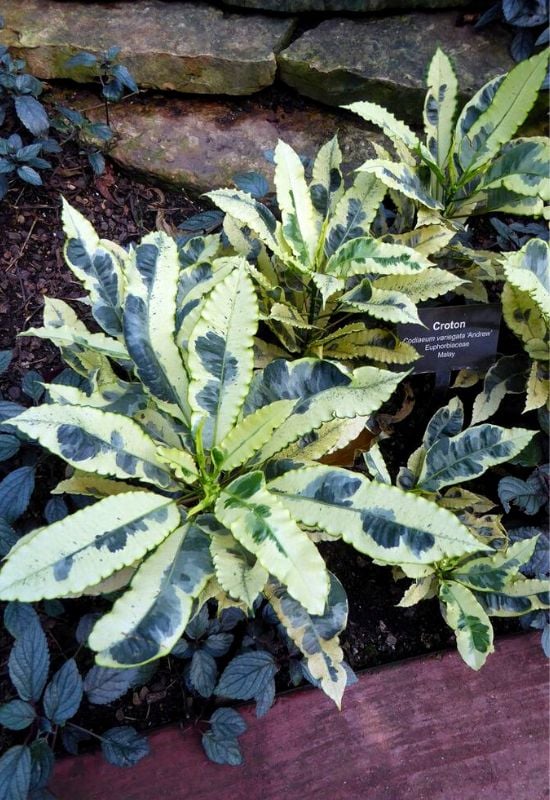
‘Andrew’ is an elegant and delicate looking cultivar or croton. It has long pointed leaves with wavy edges, and it is not as fleshy as other varieties.
The coloring too reflects this refined vocation: they have dark green edges, but most of the leaf is cream yellow, sometimes with green patches.
These form rosettes that add to the decorative and sculptural quality of this extraordinary variation on the croton theme.
‘Andrew’ is ideal for an elegant, even minimalist room, especially an office or a living room. However, you can also have it in your garden, where it can bring a touch of class.
6. ‘Picasso’s Paintbrush Croton’ (Codiaeum variegatum ‘Picasso’s Paintbrush’)
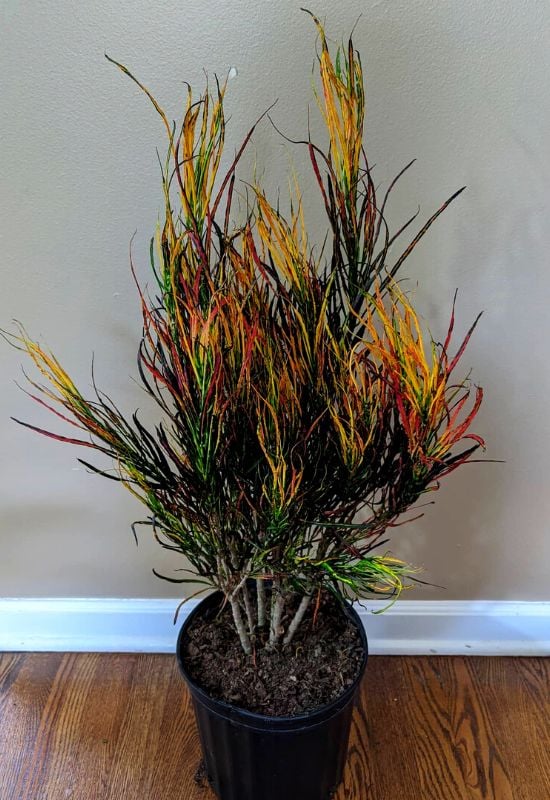
‘Picasso’s Paintbrush’ croton has long and narrow leaves, usually arching and with a thin rib in the middle.
But they are very fleshy and glossy indeed, and… Well, the name of the famous Cubist painter is not random… With patches of bright yellow, green, cream pink and dark purple (almost black), it will puzzle any onlooker like a painting with bold strokes.
They start off on the bright green to yellow scale, and add more and more shades as they mature.
Looking like colorful blades, the leaves of ‘Picasso’s Paintbrush’ croton are an asset to any indoor space that needs some vibrancy, and very useful outdoors, where it can brighten up shady and dull spots.
7. ‘Gold Star’ Croton (Codiaeum variegatum ‘Gold Star’)
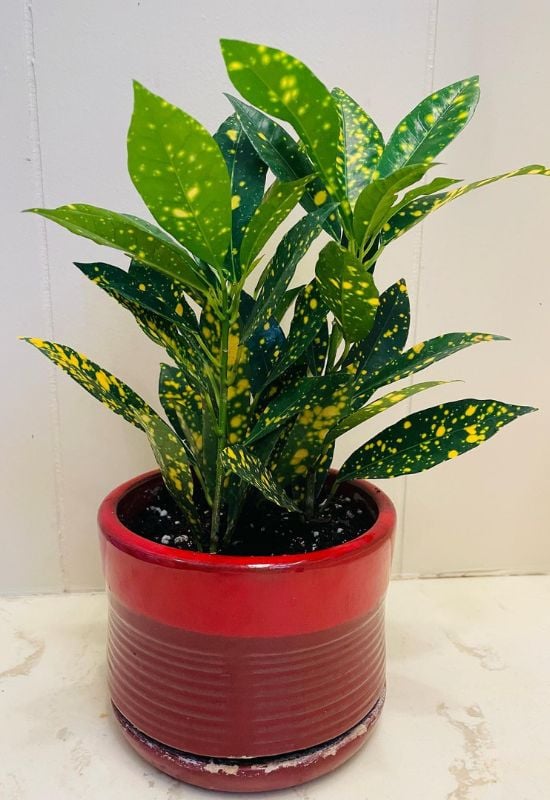
The croton cultivar ‘Gold Star’ has many similar traits with ‘Eleanor Roosevelt’ but also differences.
They have the same colors, dark green and yellow, but the latter is paler, and the distribution is different: the pale yellow is predominant, while the green is left as sparse connections between the spots.
It also has long and pointed leaves, fairly fleshy but not too much, and very glossy. Finally, it is also much smaller and it has a tree like habit.
‘Gold Star’ croton is a very elegant variety, excellent for offices and living spaces, including public ones.
It can also add an interesting touch to outdoor gardens, where it grows well in humid areas in dappled shade, where it plays with the light with wonderful effects.
8. ‘Magnificent’ Croton (Codiaeum Variogram ‘Magnificent’)
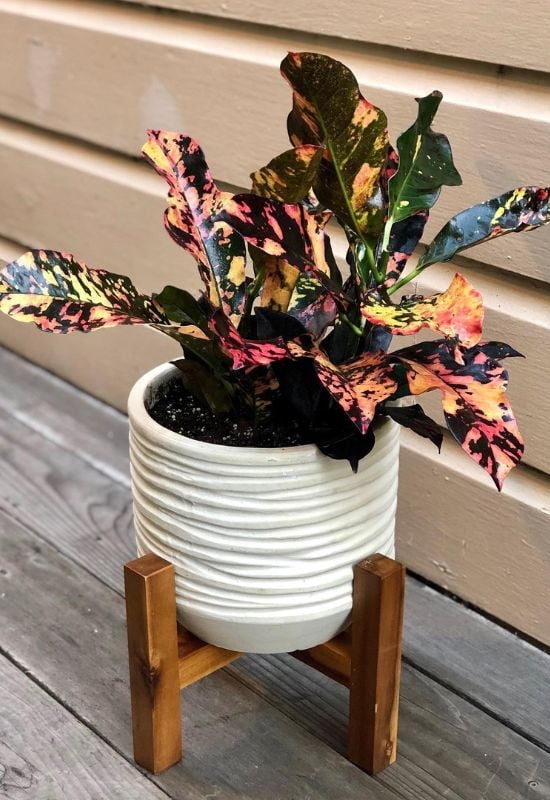
‘Magnificent’ is a croton cultivar that keeps some of the key traits of the mother species: glossy, broad, fleshy and colorful leaves. But they are more pointed and a bit narrower; and they have wavy sides.
Then, when it comes to its chromatic range, it has it all, from yellow to orange, red, green and purple, but it can add a note: bright violet patches are very, very common with this variety!
A show stopper in any indoor space, ‘Magnificent’ is arguably one of the most showy varieties of croton, and you can have it in your garden, in pots, or in the ground if you live in a hot country.
9. ‘Petra’ Croton (Codiaeum variegatum ‘Petra’)
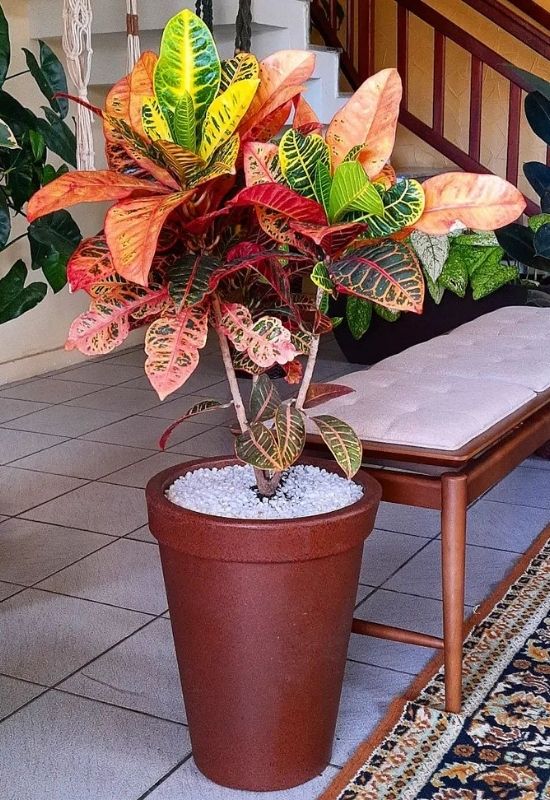
‘Petra’ is a variety of croton that is prized for the relief you find on its broad, elliptical and glossy leaves, formed by the areas between the veins.
While most of the foliage is green to dark purple when they mature, the veining will tend to yellow, orange and red. This gives you lovely patterns and a snakeskin like effect.
‘Petra’ croton will suit any indoor space, but its best position is in a large living room or office.
It is less popular than other varieties, especially outdoors, but if you like its patterns and 3D leaves, you can have it in partial shade spots.
10. Zanzibar’ Croton (Codiaeum variegatum ‘Zanzibar’)
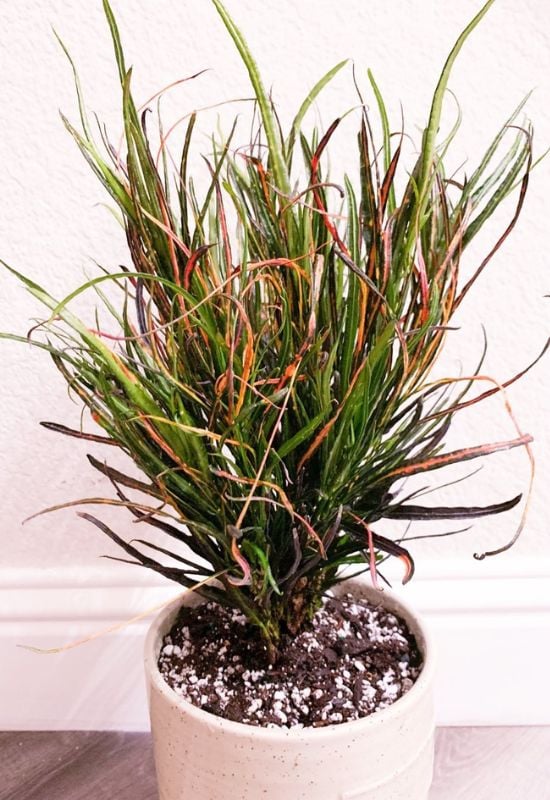
Distinctive because of its long and narrow foliage, ‘Zanzibar’ is a little rebel of the croton cultivars! The leaves are long, blade like, narrow and pointed, curving beautifully in rosettes that climb up the branches.
It may remind you of a Madagascar dragon tree (Dracaena marginate) that has gone wild with its palette! Yes, because you will find green, yellow, red, orange and purple scattered among the foliage.
Looking a bit like decorative grass, ‘Zanzibar’ croton adds a light and elegant touch to both indoor spaces and gardens; however, it will not survive outdoors unless you live in a really, really hot region.
11. Lauren’s Rainbow’ Croton (Codiaeum variegatum ‘Lauren’s Rainbow’)
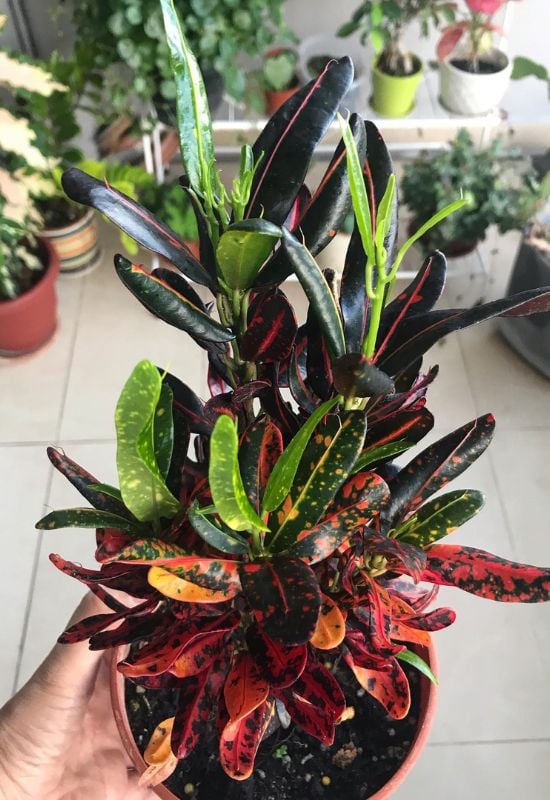
The croton cultivar ‘Lauren’s Rainbow’ has leaves that are much longer than broad, but not thin, and with a rounded tip and wavy edges.
Very glossy, sometimes curly, the leaves come on long stems and they usually display two to three colors each.
And you will find some cream white, bright green, orange, red and dark purple on them, often with edges and ribs in one shade and the rest of the leaf in another, or two in patches.
They will start off on the green white range, and then blush to warm hues as they mature.
A lovely and intriguing variety, ‘Lauren’s Rainbow’ croton mixes color and interesting shapes for a very vibrant effect.
12. ‘Gold Dust’ Croton (Codiaeum variegatum ‘Gold Dust’)
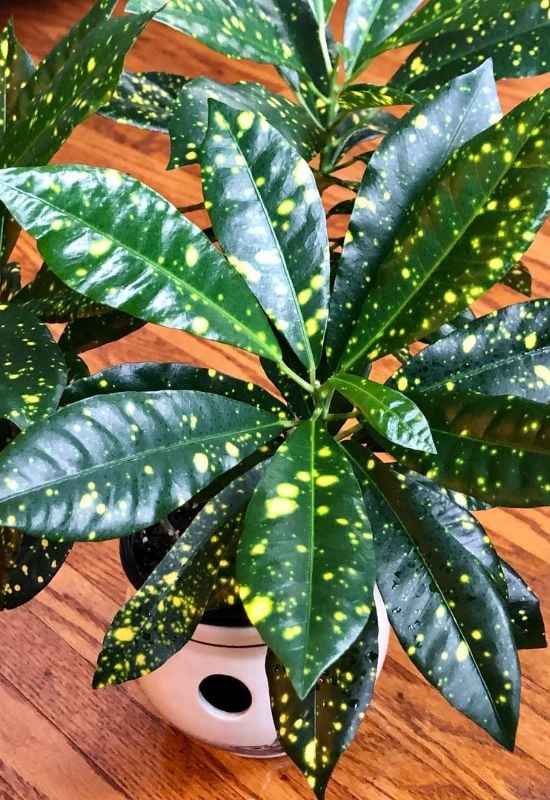
‘Gold Dust’ is a croton variety with broad, regular, clearly elliptical and fairly fleshy leaves, thick n the branches which tend to be upright.
They are bright green with a few yellow spots on them when young. However, as they age the sots darken and spread and the green become deeper as well, but they always keep their shiny gloss on them.
‘Gold Dust’ is a good indoor plant, but among the croton varieties, it is one of the best for gardens and outside growing, if you live in a warm country.
In fact, because it is pruning tolerant, tall, fairly fast growing, and it has a dense and upright habit, you can even use it for a lovely and colorful hedge!
13. ‘Oakleaf Croton’ (Codiaeum variegatum ‘Oakleaf’)
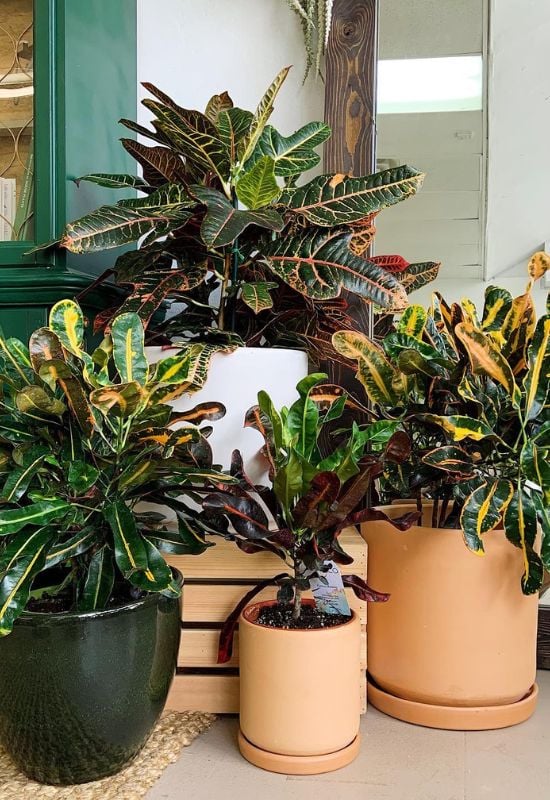
As the name suggests, ‘Oakleaf’ croton has lobed leaves, just like those of majestic oaks! But unlike those of acorn bearing shrubs, they are quite fleshy, glossy and incredibly colorful.
The veins are in relief, and usually in a chromatic range from mid to deep green and finally even greenish purple.
These draw decorative patterns among the yellow, red, pink red and even dark purple background! Quite a show stopper indeed!
Given the variegation and interesting leaf shape, ‘Oakleaf’ croton is ideal to light up a room that needs both color contrast and dynamism, this last given by the leaves that arrange in rosettes at the tips.
14. ‘Banana’ Croton (Codiaeum variegatum ‘Banana’)
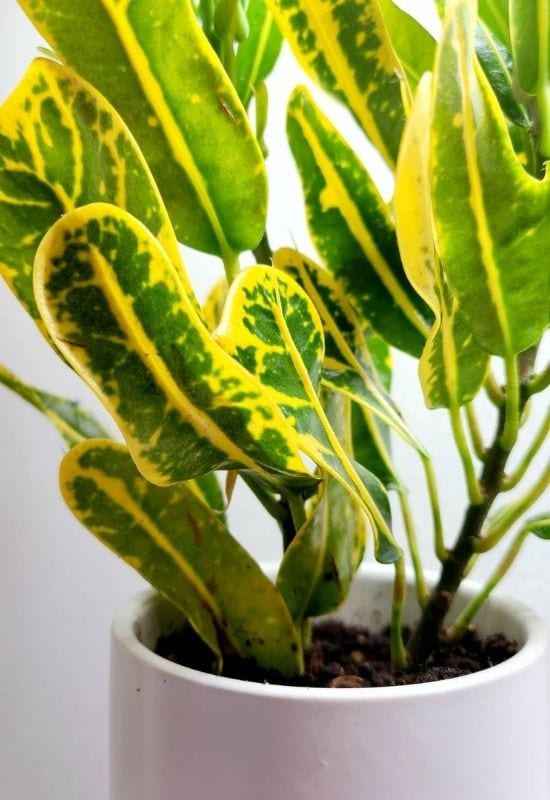
The funny and playful name of ‘Banana’ croton reflects its personality. The dense, fleshy and long leaves with rounded tips form thick and glossy clumps that curl and play light games in the sunlight.
These are dark yellow and dark green, usually striped lengthways. Very regular with its chromatic range, this is a unique variety that children love, but also adults who have not abandoned the child inside them.
Indoors, ‘Banana’ croton will remain a small plant, so it is a good choice for a small space. On the other hand, if you grow it outdoors, it will give you dense and interesting foliage to add to borders, or as a specimen plant.
15. ‘Mother and Daughter’ Croton (Codiaeum variegatum ‘Mother and Daughter’)
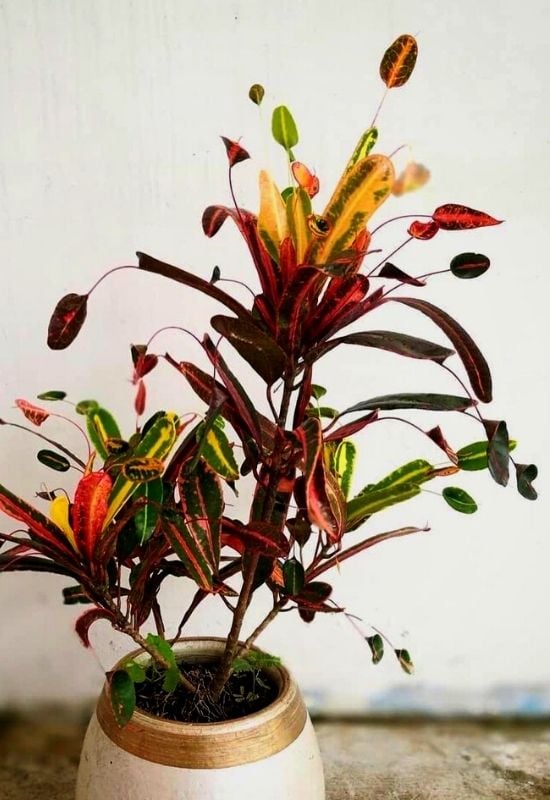
One of the weirdest varieties of croton ever, ‘Mother and Daughter’ will not wow you so much with its colors as with its leaf shape. These come on top of an upright small trunk, and they are really unusual.
They look like leaves that have a string attached to the tip, and then, at the end of this thin thread, you find another leaf… In reality, they are the same leaf, that thins down so much in the middle that it almost disappears. But the coloring is interesting too, including greens, yellow, orange, red and purple in patches along the foliage.
Very original, ‘Mother and Daughter’ croton is perfect if you want to express an eclectic personality in your living room or in an unusual office.
16. Sunny Star’ Croton (Codiaeum variegatum ‘Sunny Star’)
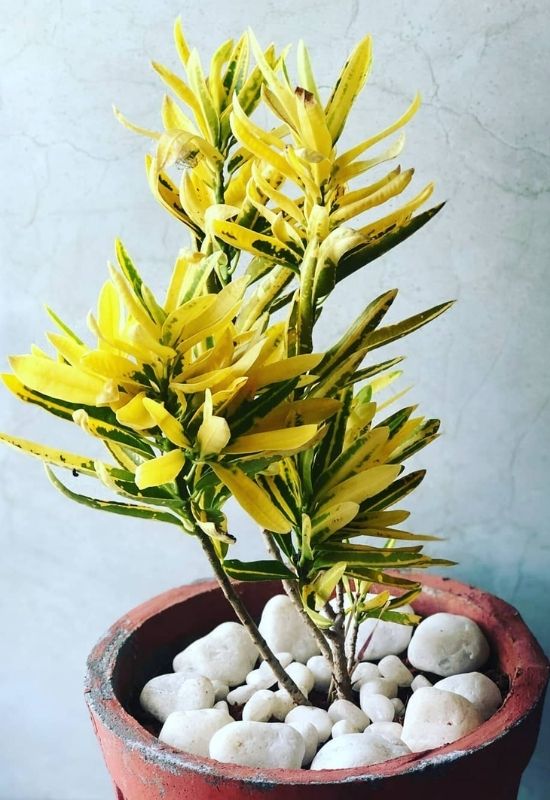
‘Sunny Star’ well describes the look and personality of this croton cultivar. A long and narrow leaf variety, with upright branches, it caps them elegantly with tufts of dense foliage, glossy and quite fleshy.
And here we see its full splendor, with dark green and golden yellow areas on the leaves.
Full of energy and very eye catching, you can even give it a helping hand… Yes, because the color changes according to how much sunlight it gets: the brighter it is the more it will turn the color of gold, or of our star, the Sun.
‘Sunny Star’ is the perfect croton variety to bring light and energy to a room; it will literally lift it with its amazing golden coloring, and even outdoors it can give you an all year round splash of light!
17. ‘Bush on Fire’ Croton (Codiaeum variegatum ‘Bush in Fire’)
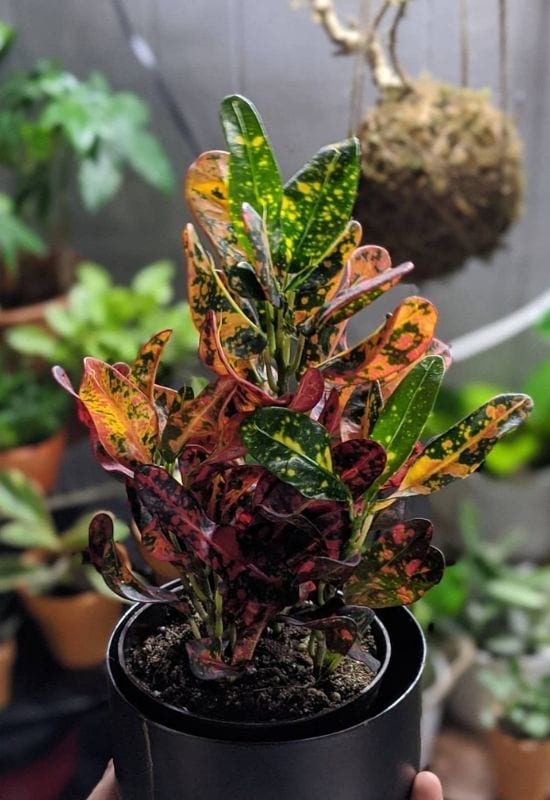
Coming on upright and thin stems or small trunks, the ‘Bush on Fire’ croton variety has some of the most vibrant color contrast effect of any of the cultivars.
They mix in a carnivalesque fashion bright and mid emerald green, yellow, red and some purple, with lovely patterns and an overall energetic effect.
Each leaf is tongue shaped, with clear veins on it, and sometimes bending and twisting. Yet again, the more it receives light, the more it will build its rainbow variegation.
Eye catching and even kaleidoscopic, ‘Bush on Fire’ is one of the most striking varieties on the market, and it will make a bold and at the same time playful and psychedelic statement. Perfect for children playrooms!
18. ‘Mrs. Ice ton’ Croton (Codiaeum variegatum ‘Mrs. Ice ton’)
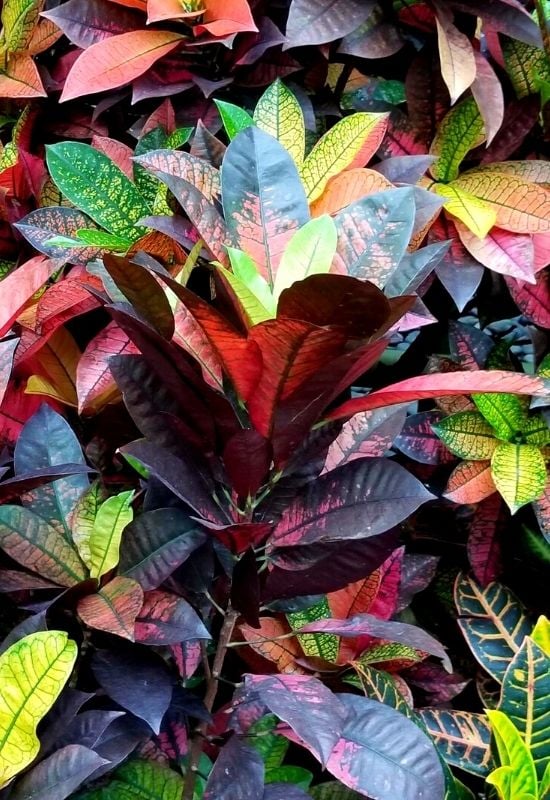
Last but not least, the cultivar ‘Mrs. Ice ton’, aptly called because it looks like the feminine version of the more popular ‘Red Ice ton’ variety.
With glossy, long and broad elliptical and pointed leaves in thick clumps, it offers a softer color contrast.
The foliage will display more pastel tones, in shades of yellow, pea and lime green, pinkish red and pale orange red, but with some dark green and purple thrown in as well!
‘Mrs. Ice ton’ offers you some of the showy elements of crotons but tempered for a more refined, less showy effect and taste – wonderful for elegant rooms that don’t want to be too glaring, but still wish to be colorful.
A Wonderful World of Colors Called Croton
No wonder crotons are some of the most loved and sought after houseplants ever, and even in exotic gardens, they can be amazing protagonists.
Thanks to breeders from all over the world, Croton variegatum has become a carnival of colors and shapes that has very, very few matches in other species.
But let’s not forget that the full potential for such amazing chromatic range and leaf variation is all in its natural genes – and once again, while we Humans have improved on it, most of the merit goes to Mother Nature!

Written By
Amber Noyes
Amber Noyes was born and raised in a suburban California town, San Mateo. She holds a master’s degree in horticulture from the University of California as well as a BS in Biology from the University of San Francisco. With experience working on an organic farm, water conservation research, farmers’ markets, and plant nursery, she understands what makes plants thrive and how we can better understand the connection between microclimate and plant health. When she’s not on the land, Amber loves informing people of new ideas/things related to gardening, especially organic gardening, houseplants, and growing plants in a small space.
